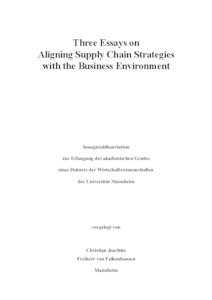|
Three essays on aligning supply chain strategies with the business environment
Falkenhausen, Christian von
![[img]](https://madoc.bib.uni-mannheim.de/43194/1.hassmallThumbnailVersion/Dissertation_Falkenhausen_final_Dekanat.pdf)  Vorschau |
|
PDF
Dissertation_Falkenhausen_final_Dekanat.pdf
- Veröffentlichte Version
Download (2MB)
|
|
URL:
|
https://ub-madoc.bib.uni-mannheim.de/43194
|
|
URN:
|
urn:nbn:de:bsz:180-madoc-431942
|
|
Dokumenttyp:
|
Dissertation
|
|
Erscheinungsjahr:
|
2017
|
|
Ort der Veröffentlichung:
|
Mannheim
|
|
Hochschule:
|
Universität Mannheim
|
|
Gutachter:
|
Fleischmann, Moritz
|
|
Datum der mündl. Prüfung:
|
15 Dezember 2017
|
|
Sprache der Veröffentlichung:
|
Englisch
|
|
Einrichtung:
|
Fakultät für Betriebswirtschaftslehre > ABWL u. Logistik (Fleischmann 2009-)
|
|
Fachgebiet:
|
330 Wirtschaft
650 Management
|
|
Normierte Schlagwörter (SWD):
|
Supply Chain Management
|
|
Freie Schlagwörter (Englisch):
|
Supply Chain Strategy , Supply Chain Alignment , Supply Chain Segmentation , Supply Chain Responsiveness , Contingency Variables
|
|
Abstract:
|
Aligning the competitive priorities of supply chains with the requirements of the business environment is critical for competing successfully in the marketplace. Nonetheless, many companies fail to develop supply chain strategies that provide a good “fit” to the characteristics of their business. The goal of the thesis at hand is therefore to provide insights for three steps that are key for attaining alignment: (1) capturing requirements of the business environment, (2) subdividing products and customers to obtain segments with distinct supply chain design requirements and (3) developing aligned supply chains strategies for each segment. The first study investigates which variables companies should analyse to capture the requirements their business. Specifically, it tests the effects hypothesized to be underlying the five most frequently cited contingency variables in the literature on supply chain strategy. The results indicate that demand variability and the customer lead time requirements are important for setting competitive priorities because they influence whether companies require market mediation capabilities to fulfil demand as requested by customers. Volume, variety and lifecycle duration are less important for this purpose, but may instead be used for analysing the causes of variable demand. The second study investigates how companies can subdivide a heterogeneous set of products or customers into groups (“segments”) that require distinct supply chain strategies. The study uses clustering and classification to form segments quantitatively and compares the results to segments that were formed based on managers’ tacit knowledge. The findings indicate that managers may choose segments that do not reflect the needs of their business environment, consequently pursuing supply chain strategies that adversely affect financial performance. Clustering and classification help managers detect such segment-environment mismatches and thus serve as valuable tools for challenging managers’ judgment. Lastly, to facilitate the derivation of aligned supply chain strategies, the third study investigates in which business environments companies should prioritize responsiveness, i.e., the ability to fulfil orders within a time frame that is acceptable to the customer. As the extant literature provides inconsistent recommendations in this regard, the study analyses both the benefits and the costs of shorter lead times. The results suggest that responsiveness can increase financial performance in two distinct ways: either by matching supply and demand or by decreasing supply chain related costs depending on the characteristics of the products that are being sold.
|
 | Dieser Eintrag ist Teil der Universitätsbibliographie. |
 | Das Dokument wird vom Publikationsserver der Universitätsbibliothek Mannheim bereitgestellt. |
 Suche Autoren in Suche Autoren in
Sie haben einen Fehler gefunden? Teilen Sie uns Ihren Korrekturwunsch bitte hier mit: E-Mail
Actions (login required)
 |
Eintrag anzeigen |
|
|
